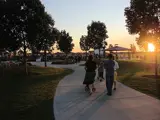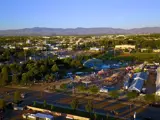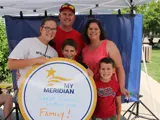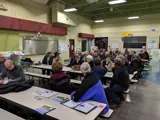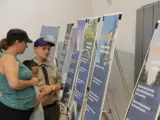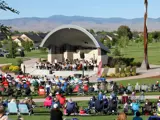Introduction
Comprehensive Plan: Chapter 1
Overview
Meridian, Idaho is located just west of Boise in the southwestern part of Idaho, and is one of six cities in Ada County. The Area of City Impact contains 60 square miles, including approximately 33 square miles within the city limits. As of 2019 there are over 114,000 residents in Meridian, making it the second largest city in Idaho—and one of the top ten fastest growing communities in the nation. It has become the area’s new regional epicenter.
This Comprehensive Plan is the guide to the future of the City of Meridian. It builds on Meridian’s history and community wishes, integrates previous and upcoming plans and projects, and recognizes the contributions of our leaders and community members that have made Meridian of the most desirable places to live. Thoughtful and deliberate planning is imperative to preserve and improve upon the current quality of life.
As part of the Introduction, the following elements are included in this chapter:
"Planning is bringing the future into the present so that you can do something about it now." - Alan Lakein
Figure 1A: Regional Context Map
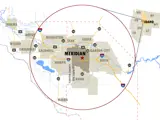
Plan Purpose and Scope
The purpose of the City of Meridian’s Comprehensive Plan (Plan) is to integrate the values of the community into a document that guides the growth and development of the City. The Plan uses maps, tables, and narrative to describe the City, provide a vision of a desired future, and recommend specific policies and actions to reach that future.
The goal of the Comprehensive Plan is to create an effective vision and source document that the general public, developers, and decision makers can use to ensure Meridian is a premier place to live, work and raise a family.
The required components of a comprehensive plan specified in Idaho Code include private property rights; population; economic development; land use; natural resources; hazardous areas; public services, school facilities; transportation; recreation; special areas or sites; housing; community design; implementation; agriculture; airports; national interest electric transmission corridors; and any other component that may be necessary.
One of the primary uses of the Comprehensive Plan is to provide direction for land use regulations, including zoning, as well as strategic plans, municipal budget and capital projects, and other implementation actions. Idaho Code § 67-6511 requires: “The zoning districts shall be in accordance with the adopted plans.”
All legislative requirements, specifically the Idaho Local Land Use Planning Act, are addressed in the Plan. Idaho Code § 67-6508 (the Local Land Use Planning Act) provides for a planning process as follows:
“Prepare, implement, and review and update a comprehensive plan, hereafter referred to as the plan. The plan shall include all land within the jurisdiction of the governing board. The plan shall consider previous and existing conditions, trends, desirable goals and objectives, or desirable future situations for each planning component.”
The Plan is intended to work in concert with the City’s ordinances and specific area plans. It is based not only on the concerns and expressions of the community, but upon the analysis in the Existing Conditions Report that is adopted concurrently as Volume II of this Plan. The Existing Conditions Report includes background information and analysis about the built and natural environment in Meridian today (as of 2017), trends, and a strategic plan for the future. Together, the Existing Conditions Report and the Comprehensive Plan together address all of the elements required in the Local Land Use Planning Act of Idaho.
This Plan applies to all geographic areas within Meridian’s jurisdiction, including its surrounding Area of City Impact. Plan goals, objectives, and action items are designed to address a 20-year planning horizon.
Nature of the Plan
The Comprehensive Plan is an official policy guide for decisions concerning the physical development of the community. The Plan establishes goals, objectives, and action items to implement the City’s policies regarding growth. The Plan works in concert with City Code and other planning-related documents like the City’s Strategic Plan, the City’s Sewer and Water Master Plans, the Pathways Master Plan, Parks and Recreation Master Plan, and Capital Improvement Plans (CIPs). It is also used in conjunction with each City department’s strategic and tactical plans. The Plan is not a set of standards or a means to enforce City Code. Instead, it indicates, in a general way, how the community should develop. It is expected and required that the Plan consider and inform efforts to align City Code and policy with the community’s changing shape, values, and needs.
Citizens, developers, the Planning and Zoning Commission, as well as the City Council and other groups are all involved in shaping community development and have a primary responsibility to coordinate and direct the overall pattern of development activities within the community. The City Council, with recommendation from the Planning and Zoning Commission, makes development decisions concerning annexation, rezoning, and subdivision developments at public hearings, as well as decisions regarding variances, and planned unit developments. The Planning and Zoning Commission is responsible for making decisions regarding conditional use permits. Due to the responsibilities of the City Council, it is necessary for the City to implement technical guidelines and adopt policies that will provide the framework for considering proposed physical development and its suitability, impact on the quality of life for Meridian citizens, and the best interest of the City. The City also needs to establish and maintain a long-range implementation strategy for coordinated, unified development of public improvement projects.
Plan History and Preparation
Meridian’s first Comprehensive Plan was adopted in 1978. That plan was developed to meet the requirements of the newly enacted 1975 Land Use Planning Act of the State of Idaho, Title 67, Chapter 65. In 1993, the City of Meridian invited citizens representing neighborhood groups, developers, real estate professionals, and public agencies to engage in a participatory process to revise a modernized City of Meridian Comprehensive Plan. Similar processes took place again in 2002 and 2011 to bring needed revisions to the Meridian Comprehensive Plan.
To ensure that the Plan remains relevant and represents current stakeholders, reflects market and demographic trends, is accessible for all users, and offers ease of navigation through its content, today’s City leaders recognize changes are needed. Many goals, objectives, and actions outlined in the 2011 plan remain. However, some objectives and action items have been achieved or are no longer desired. Additionally, new initiatives focus on creation and preservation of the area’s character, evolution, livability, vibrancy, and connections.
#MyMeridian Vision
The Plan establishes a future vision and course of action based on the values and feedback of the community. The overall #MyMeridianVision statement, developed by the people of Meridian, represents their voice about what they value in the community and an equally strong mandate for what they want for the future. It embodies these unique qualities and reaffirms a desire to preserve Meridian’s character with the onset of inevitable changes that come with population growth and demand for development. Building on the #MyMeridianVision, the City has established five Citywide Vision Themes to bring together City departments and trained staff that are committed to the City’s core values to guide growth, create jobs and a sound economic base, provide services, facilitate neighborhood sustainability, and be good stewards of the public trust.
"Don’t judge each day by the harvest you reap but by the seeds that you plant." - Robert Louis Stevenson
#MyMeridian Vision
Meridian is a premier, evolving, livable, vibrant, and connected community.
The Vision Themes and corresponding statements will be regularly revisited after the adoption of the Plan. As a valuable tool to be reviewed and updated over the 20-year planning horizon, these vision statements reflect the community’s values and dreams for the future of the City of Meridian:
- Premier Community A vibrant, diverse, clean, safe, and secure community in which to live, work, and thrive.
- Evolving Community A community thoughtfully adapting to changes.
- Livable Community A community of family-friendly, healthy, and engaging places.
- Vibrant Community A community strengthened by historic character and vibrant activity centers.
- Connected Community A community of safe and efficient transportation.
Planning Successes
Meridian’s rapid growth has propelled the City into continual change. Development and infrastructure must be directed to create neighborhoods and centers that foster social interaction, public safety, and a sense of community for the City’s residents and commerce. Without a coordinated plan for the City, unguided growth could harm the vital qualities clearly articulated in the #MyMeridianVision. Having a community-vested vision and plan helps guide and inform the decision-making process to define and manage the City’s future.
Meridian has seen a significant increase in population over the last decade and it is predicted to grow another 52% between 2017 and 2040. During the last 10 years (2007–2017), the City has seen 37% growth in the labor force and a 5% reduction in the unemployment rate. The median household income is well over the Treasure Valley average, and two-thirds of the children in the community have walkable access to a park or open space.
With a strong vision for managing community growth, the City will apply the values defined by the #MyMeridianVision to harness growth as a community asset. Strategic long-range planning is an opportunity to influence the trajectory—to set a compelling, prescribed, and collaborative course for the future. Over the lifetime of the Plan, a single policy change can produce enormous and valued impact.
Accomplishments in the last 10 years include:
- Enhanced traffic operations using agency technology and the addition of new pathways
- Hosted over 100 events in 2018 alone
- Welcomed Idaho State University and Idaho College of Osteopathic Medicine, Idaho’s first medical school
- Worked toward the “greening” of Meridian with 4,736 trees in Meridian’s parks
- Opened the Public Safety Training Center on Watertower Street
- Developed Village at Meridian, a new premiere lifestyle center with over a million square feet of retail and office space
- Relaunched the Main Street Market
- Partnered on Harvest Transit, an on-demand service designed for seniors and those with disabilities
- Invested in and expanded public art with dedicated funding, park themes and more
- Created and expanded the Historic Walking Tour with new partnerships
- Started building up the Ten Mile Interchange area
- Completed Split Corridor road investments in Downtown
- Expanded Storey Park with new dog park—Storey Bark Park
Plan Structure
The Comprehensive Plan is structured around five Vision Themes and their corresponding topic elements. Each Vision Theme chapter includes a brief explanation about its topics and lists the relevant policy direction, including goals, objectives, and action items.
Chapter 1. Introduction: plan purpose and scope, #MyMeridianVision, planning successes, plan structure, a community-driven plan, overview of sustainable growth and development, and making the plan reality
Chapter 2. Premier Community: housing, education and services, and economic development
Chapter 3. Evolving Community: growth and population, land use, and utilities and infrastructure
Chapter 4. Livable Community: parks and pathways, stewardship, public safety
Chapter 5. Vibrant Community: character and design, historic preservation, and arts/culture
Chapter 6. Connected Community: transportation and streets
The Appendices includes the Future Land Use Map, Glossary of Terms, Acronyms and Abbreviations, and a Regulatory Takings Checklist.
Using this Document
The Comprehensive Plan is designed to serve a diverse audience: citizens, applicants for development, City staff, commissioners, and elected officials. The purpose of the Plan is to provide a clear vision for the future by outlining expectations of the community. The Plan facilitates this by establishing policies that describe City led initiatives, and by establishing expectations for approvals of development applications. The intent is to initiate greater certainty in creating successful projects that match the City’s vision; address the concerns and property rights of neighbors; and provide the flexibility to accomplish a developer’s vision without compromising the larger community’s vision and goals.
Citizens are encouraged to use this document to better understand the City’s vision for their neighborhood, their business, and the City as a whole. Applicants for development are also encouraged to use this document to better understand the City’s vision.
Finally, this document will be utilized in earnest by City staff, City commissions and task forces, and elected officials as the roadmap to achieving the Vision Themes; the Planning Department in reviewing development applications, all departments in crafting their strategic plans; and in developing and implementing capital improvement and master plans.
Online Living Document
The full power and utility of this Plan is best experienced in its online form. In the online format, the Plan is designed to be fully navigable, searchable, and interconnected with hyperlinks. Relevant text and graphics are designed to be easily excerpted for applicable use. The maps and graphics are interactive in order to enhance their value. Hyperlinks are available and will be maintained with other supporting documents, including the topic-specific plans that support this Plan, and are essential to its full and effective implementation.
A Community-Driven Plan
The Comprehensive Plan captures the community’s values in 2019 and how the community envisions Meridian in the future. As such, it is critical to authentically integrate the concerns and expressions of the community and its stakeholders into the document that will guide the growth and development of the City.
The first step toward creating a vision for the community was listening. Public input and leadership from the Steering Committee, Planning and Zoning Commission, City Council, and Boards and Commissions guided the planning process. Diligent effort encouraged meaningful public participation by involving interested parties early and frequently.
At these events and through online surveys, participants were asked questions like “What do you love about Meridian?”, “What would you improve about Meridian?” and “What is your vision for Meridian’s future?” This allowed the residents, employees, and other community members the opportunity to provide and discuss their values, options, goals.
5,500 community participants provided feedback at community events, workshops, and through online engagement polls and surveys.
Overview of Sustainable Growth and Development
Review of recent research and tools
Getting the timing and appropriate land uses right, today and in the future, is at the heart of managing growth and the character of Meridian. Decisions about how, where, and what kind of development takes place in the future will affect other aspects of Meridian, including traffic, noise air and environmental quality; opportunities for jobs, housing and business development; community character and design; and the need for public facilities and services of all types.
An example is the relationship between traffic, commercial development, and transportation investment decisions. Providing expanded opportunities and access to neighborhood shopping and live-work units could result in reduced pressure on roadways. As with commercial development, the level of residential density near future transportation hubs influences the timing and investment in public transit services and infrastructure. Choices about housing types and location will influence future decisions about both commercial and transportation investments.
Through the Comprehensive Plan process, several levels of analysis were conducted to reflect how these topical layers influence each other and should be considered into the future:
Service Impact Tool
A service impact tool was developed for use by staff to evaluate the serviceability of a parcel at the time annexation is requested. The intent is to promote thoughtful growth by clearly considering and reporting relevant factors to City leaders as they consider development proposals. The tool may also be used as a framework to set priorities, and to identify areas that that are likely to develop first.
This tool considers both areas that already receive city services and those that haven’t. The tool looks at a number of attributes and ranks each criterion on a numeric scale. Attributes include among other things, proximity to water, and sewer infrastructure, proximity to schools and pathways, emergency services’ response time, and environmental constraints. Over time, it is envisioned that the service impact tool will help the City coordinate services so growth is strategic and more consistent with plans for infrastructure.
Economic Development Analysis and Market Analysis
One objective of the Comprehensive Plan is to strategically prepare for land use and transportation investments that will support economic development across the City. An analysis of economic development trends, regional demographics, Meridian’s industry strengths, and anticipated areas of employment growth was conducted as part of Plan development, and concluded with recommendations for this Plan that are informed by data, interviews with economic development stakeholders across the region, and best practices.
Corridor Analysis
A focused review of key corridors in Meridian was conducted to evaluate whether planned land uses have the right mix and scale to support transit in the future. This analysis aims to ensure that land uses provide enough potential ridership to support transit investments, while also leveraging each unique corridor’s development context. The study also identified opportunities to capture the value of real estate and economic development along each corridor to support funding of a future transit system.
Making the Plan Reality
A wide range of users can find meaning in this Plan. Citizens, developers, the Planning and Zoning Commission, as well as the City Council and other commissions are all involved and responsible for shaping community development and the overall pattern of growth within the community.
Alignment with other Plans and Resources
The Comprehensive Plan becomes an improved tool for growth by driving the process of alignment with other plans, code, and policy updates and goals for the City. The specific plans and documents that are adopted as part of the Comprehensive Plan are listed at the front of the Plan (List of Adopted Plans by Reference).
The City hereby adopts as addenda to the Comprehensive Plan the versions of these documents in the List of Adopted Plans by Reference in effect at the time the Comprehensive Plan is approved by the City Council, and as amended.
The Comprehensive Plan provides the overarching vision for updates and revisions to City Code, and works symbiotically with the City’s Community Development Block Grant Consolidated Plan, the City’s Sewer and Water Master Plans, other department master plans, capital improvement plans, and various transportation plans and studies. It is also used in conjunction with each City department’s strategic plan, action plan, and annual employee performance appraisal.
All City departments shall use the Comprehensive Plan as a tool for setting work plans, budgets, capital improvements, amending the City Code, and allocating other resources for City Council approval. City staff from all departments will regularly discuss and coordinate the needs of the City. Staff will work together with the common goal of guiding growth, providing City services within available resources, being organized and efficient, and acting as good stewards of the public trust.
Next Steps
Implementation of the Plan will take hard work and dedication from the entire community. Many of these actions have already started based on community input. After adoption of the Comprehensive Plan, one of the first steps will be to prioritize the action items listed in the Plan. City Departments and other stakeholders will be part of the process to determine which action items are immediate, intermediate, or long-term priorities. This consolidated list of the action items will be referred to as the Implementation Plan of the Comprehensive Plan and it will establish both an action item lead and support, including all City departments or civic organizations that need to be involved in completing each action. After staff consensus on priorities, the draft policies will be shared with the Mayor and City Council. The intent of the Implementation Plan is to provide transparency to the community and ensure timely execution of the Comprehensive Plan’s action items through assigned responsibilities and priorities.
On a regular basis, City staff will report to Council progress made toward completing action items. It is also anticipated that additional action items may be added and an update to both the text of the Comprehensive Plan and the Existing Conditions Report will occur on a bi-annual basis, and/or as otherwise needed.
"The unique characteristics of place may be the only truly defensible source of competitive advantage for cities & towns." - Joe Cortright, CEO's for Cities


